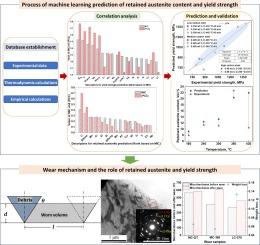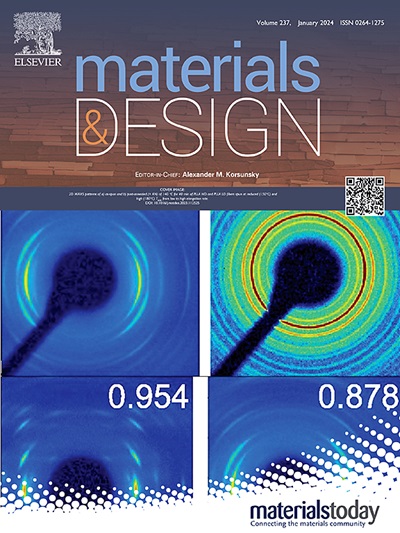Data-driven predictions of retained austenite content and yield strength and elucidation of the sliding wear performance of carbide-free bainitic steels
IF 7.6
2区 材料科学
Q1 MATERIALS SCIENCE, MULTIDISCIPLINARY
引用次数: 0
Abstract
Carbide-free bainitic (CFB) steels have drawn much attention due to their high strength and toughness. The present work aims to build machine learning (ML) based surrogate models to predict retained austenite (RA) content and yield strength (YS) of isothermal transformed CFB steels and study the sliding wear performance. The input data for ML prediction were related to compositions, heat treatment process, and phases. The Random Forest regression and Gaussian process regression were respectively selected to build the predictive models for RA content and YS. Result shows that the predicted RA content agrees well with the experimentally determined ones in steel with high stability of untransformed austenite. For YS prediction, the present surrogate model can predict YS of CFB steels even without additional microstructural information such as dislocation and effective substructure size. Steels with different YS and RA content were designed to study the sliding wear performance. Result shows that the dominant wear mechanism of the tested steels is abrasive wear and the weight loss is inversely proportional to hardness when the load and wear distance are constant. Increasing YS and RA content can increase the initial hardness and work hardening ability at the worn surface, thereby enhancing wear resistance.

数据驱动的残余奥氏体含量和屈服强度预测以及无碳化物贝氏体钢滑动磨损性能的阐明
无碳化物贝氏体(CFB)钢因其高强度和韧性而备受关注。本研究旨在建立基于机器学习(ML)的代用模型,以预测等温转变 CFB 钢的残余奥氏体(RA)含量和屈服强度(YS),并研究其滑动磨损性能。用于 ML 预测的输入数据与成分、热处理工艺和相位有关。分别选择随机森林回归和高斯过程回归建立 RA 含量和 YS 的预测模型。结果表明,在未转变奥氏体稳定性较高的钢中,预测的 RA 含量与实验测定的 RA 含量非常吻合。在 YS 预测方面,即使没有额外的微观结构信息(如位错和有效子结构尺寸),本替代模型也能预测 CFB 钢的 YS。设计了不同 YS 和 RA 含量的钢材来研究滑动磨损性能。结果表明,测试钢材的主要磨损机制是磨料磨损,当载荷和磨损距离不变时,重量损失与硬度成反比。增加 YS 和 RA 的含量可提高初始硬度和磨损表面的加工硬化能力,从而增强耐磨性。
本文章由计算机程序翻译,如有差异,请以英文原文为准。
求助全文
约1分钟内获得全文
求助全文
来源期刊

Materials & Design
Engineering-Mechanical Engineering
CiteScore
14.30
自引率
7.10%
发文量
1028
审稿时长
85 days
期刊介绍:
Materials and Design is a multi-disciplinary journal that publishes original research reports, review articles, and express communications. The journal focuses on studying the structure and properties of inorganic and organic materials, advancements in synthesis, processing, characterization, and testing, the design of materials and engineering systems, and their applications in technology. It aims to bring together various aspects of materials science, engineering, physics, and chemistry.
The journal explores themes ranging from materials to design and aims to reveal the connections between natural and artificial materials, as well as experiment and modeling. Manuscripts submitted to Materials and Design should contain elements of discovery and surprise, as they often contribute new insights into the architecture and function of matter.
 求助内容:
求助内容: 应助结果提醒方式:
应助结果提醒方式:


